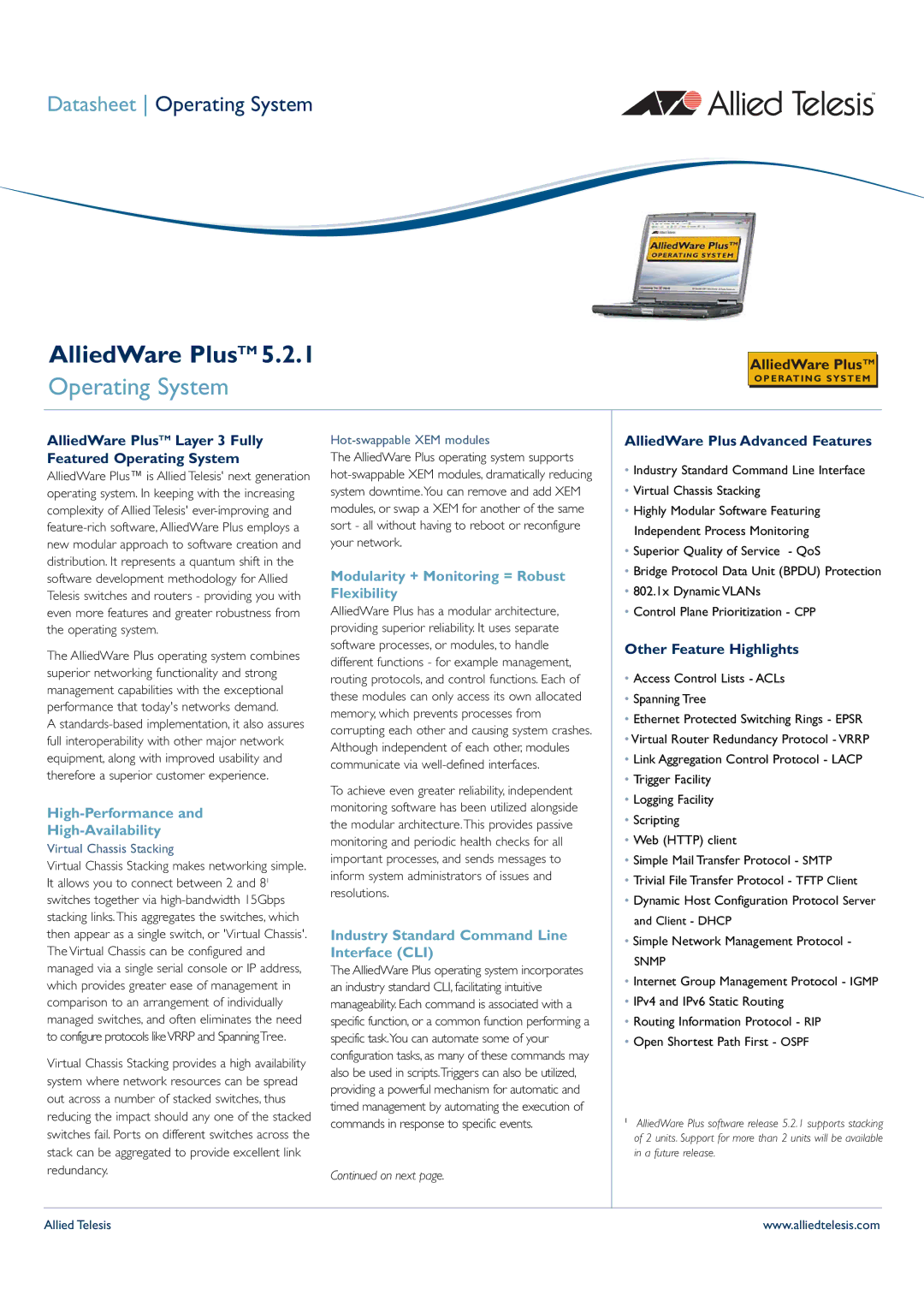
Datasheet Operating System
AlliedWare PlusTM 5.2.1
Operating System
AlliedWare PlusTM
OPERATING SYSTEM
AlliedWare PlusTM Layer 3 Fully Featured Operating System
AlliedWare Plus™ is Allied Telesis' next generation operating system. In keeping with the increasing complexity of Allied Telesis'
The AlliedWare Plus operating system combines superior networking functionality and strong management capabilities with the exceptional performance that today's networks demand.
A
High-Performance and
High-Availability
Virtual Chassis Stacking
Virtual Chassis Stacking makes networking simple. It allows you to connect between 2 and 81 switches together via
Virtual Chassis Stacking provides a high availability system where network resources can be spread out across a number of stacked switches, thus reducing the impact should any one of the stacked switches fail. Ports on different switches across the stack can be aggregated to provide excellent link redundancy.
Hot-swappable XEM modules
The AlliedWare Plus operating system supports
Modularity + Monitoring = Robust Flexibility
AlliedWare Plus has a modular architecture, providing superior reliability. It uses separate software processes, or modules, to handle different functions - for example management, routing protocols, and control functions. Each of these modules can only access its own allocated memory, which prevents processes from corrupting each other and causing system crashes. Although independent of each other, modules communicate via
To achieve even greater reliability, independent monitoring software has been utilized alongside the modular architecture.This provides passive monitoring and periodic health checks for all important processes, and sends messages to inform system administrators of issues and resolutions.
Industry Standard Command Line Interface (CLI)
The AlliedWare Plus operating system incorporates an industry standard CLI, facilitating intuitive manageability. Each command is associated with a specific function, or a common function performing a specific task.You can automate some of your configuration tasks, as many of these commands may also be used in scripts.Triggers can also be utilized, providing a powerful mechanism for automatic and timed management by automating the execution of commands in response to specific events.
Continued on next page.
AlliedWare Plus Advanced Features
•Industry Standard Command Line Interface
•Virtual Chassis Stacking
•Highly Modular Software Featuring Independent Process Monitoring
•Superior Quality of Service - QoS
•Bridge Protocol Data Unit (BPDU) Protection
•802.1x Dynamic VLANs
•Control Plane Prioritization - CPP
Other Feature Highlights
•Access Control Lists - ACLs
•Spanning Tree
•Ethernet Protected Switching Rings - EPSR
•Virtual Router Redundancy Protocol - VRRP
•Link Aggregation Control Protocol - LACP
•Trigger Facility
•Logging Facility
•Scripting
•Web (HTTP) client
•Simple Mail Transfer Protocol - SMTP
•Trivial File Transfer Protocol - TFTP Client
•Dynamic Host Configuration Protocol Server and Client - DHCP
•Simple Network Management Protocol -
SNMP
•Internet Group Management Protocol - IGMP
•IPv4 and IPv6 Static Routing
•Routing Information Protocol - RIP
•Open Shortest Path First - OSPF
1AlliedWare Plus software release 5.2.1 supports stacking of 2 units. Support for more than 2 units will be available in a future release.
Allied Telesis | www.alliedtelesis.com |
